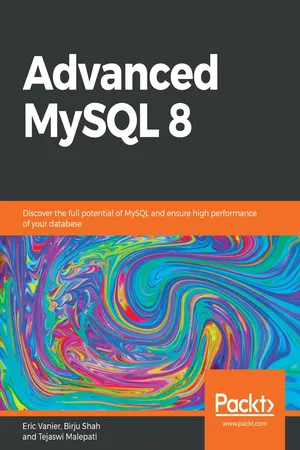
Advanced MySQL 8
Discover the full potential of MySQL and ensure high performance of your database
- 286 pages
- English
- ePUB (mobile friendly)
- Available on iOS & Android
Advanced MySQL 8
Discover the full potential of MySQL and ensure high performance of your database
About this book
Design cost-efficient database solutions, scale enterprise operations and reduce overhead business costs with MySQL
Key Features
- Explore the new and advanced features of MySQL 8.0
- Use advanced techniques to optimize MySQL performance
- Create MySQL-based applications for your enterprise with the help of practical examples
Book Description
Advanced MySQL 8 teaches you to enhance your existing database infrastructure and build various tools to improve your enterprise applications and overall website performance. The book starts with the new and exciting MySQL 8.0 features and how to utilize them for maximum efficiency. As you make your way through the chapters, you will learn to optimize MySQL performance using indexes and advanced data query techniques for large queries. You will also discover MySQL Server 8.0 settings and work with the MySQL data dictionary to boost the performance of your database. In the concluding chapters, you will cover MySQL 8.0 Group Replication, which will enable you to create elastic, highly available, and fault-tolerant replication topologies. You will also explore backup and recovery techniques for your databases and understand important tips and tricks to help your critical data reach its full potential.
By the end of this book, you'll have learned about new MySQL 8.0 security features that allow a database administrator (DBA) to simplify user management and increase the security of their multi-user environments.
What you will learn
- Explore new and exciting features of MySQL 8.0
- Analyze and optimize large MySQL queries
- Understand MySQL Server 8.0 settings
- Master the deployment of Group Replication and use it in an InnoDB cluster
- Monitor large distributed databases
- Discover different types of backups and recovery methods for your databases
- Explore tips to help your critical data reach its full potential
Who this book is for
Advanced MySQL 8 is for database administrators, data architects, and database developers who want to dive deeper into building advanced database applications in the MySQL environment.
Frequently asked questions
- Essential is ideal for learners and professionals who enjoy exploring a wide range of subjects. Access the Essential Library with 800,000+ trusted titles and best-sellers across business, personal growth, and the humanities. Includes unlimited reading time and Standard Read Aloud voice.
- Complete: Perfect for advanced learners and researchers needing full, unrestricted access. Unlock 1.4M+ books across hundreds of subjects, including academic and specialized titles. The Complete Plan also includes advanced features like Premium Read Aloud and Research Assistant.
Please note we cannot support devices running on iOS 13 and Android 7 or earlier. Learn more about using the app.
Information
InnoDB Cluster in MySQL 8.0
- What InnoDB cluster is
- InnoDB cluster requirements
- Creating a MySQL InnoDB cluster
- Routers in InnoDB cluster
- Managing InnoDB cluster
- InnoDB cluster limitations
- Storage engines
What is InnoDB cluster?

- Configure, create, and check the status of groups
- Configure, add members, and remove members
- Create sandbox environments for testing
InnoDB cluster requirements
- Python Version 2.7 or higher is required for MySQL Shell to work, and is required for all machines that are part of a group; for Windows, MySQL Shell bundles Python
- MySQL Router, MySQL Shell, and MySQL server should already be downloaded and installed on the servers before configuring InnoDB cluster
- InnoDB must be used as a storage engine for all tables
Installing MySQL Shell
sudo apt-get update
sudo apt-get install mysql-shell
> sudo apt-get update
> sudo apt-get install mysql-apt-config
> sudo apt-get install mysql-shell
> sudo yum install mysql-shell How to use ...
Table of contents
- Title Page
- Copyright and Credits
- About Packt
- Contributors
- Preface
- Introduction
- MySQL 8's New Features
- Indexing Your Data for High Performance
- Advanced Data Techniques for Large Queries
- MySQL Data Dictionary in MySQL 8.0
- MySQL Server Settings
- Group Replication in MySQL 8.0
- InnoDB Cluster in MySQL 8.0
- Monitoring Your Large Distributed Databases
- Authentication and Security Management with MySQL 8.0
- Advanced MySQL Performance Tips and Techniques
- Other Books You May Enjoy